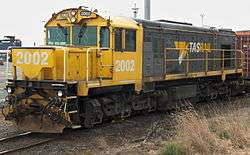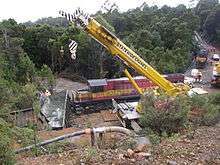| DQ class |
|---|
 |
|
|
|
|
| Performance figures |
|---|
| Maximum speed |
80 km/h (50 mph) |
|---|
| Power output |
1,120 kW (1,500 hp) |
|---|
| Tractive effort |
1,230 kW (1,650 hp) |
|---|
|
| Career |
|---|
| Operators |
AN Tasrail
Pacific National
TasRail |
|---|
| Number in class |
12 |
|---|
| Numbers |
2001 - 2012 |
|---|
| Delivered |
September 1998 - October 1999 |
|---|
| First run |
September 1998 - October 1999 |
|---|
| Withdrawn |
2015 - present |
|---|
| Current owner |
TasRail |
|---|
| Disposition |
8 in service
3 withdrawn
1 undergoing conversion to driving trailer |
|---|
|
The DQ class were a class of diesel locomotives in New Zealand and Tasmania. Originally built by Clyde Engineering in the 1960s as Queensland Rails 1460 and 1502 class locomotives. They were purchased by Tranz Rail in 1995 to be rebuilt, as a cheaper alternative to buying new locomotives. Tranz Rail rebuilt 16 locos into the DQ class. Tranz Rail then sold the 12 DQs to AN Tasrail. Only eight out of the twelve DQs are still in service today.
Introduction and service
Following the rebuilding of the DQ and QR class locomotives at Tranz Rails Hutt Workshops, Tranz Rail sold twelve DQs due to a locomotive shortage due to the planned replacement of Tasrails English Electric locomotive fleet. DQs 2001 and 2002 were repainted into the ATN Red livery. Due to the Australian Transport Network not being impressed with the looks and the cost of the livery,[2] the rest of the locomotives were repainted into the Wisconsin Central Maroon livery.[3][4] With the sales of the twelve locomotives, they were renumbered in the 20XX series from the 60XX series (1502 class rebuilds) and 63XX (1460 class rebuilds), as they were in New Zealand.
On 2 September 1998, DQs 2001 and 2002 arrived in Bell Bay.[5][4] After arrival, the locomotives were towed to Tasrails East Tamar Workshops for adjustments and testing, before entering service later that month.[6] A second batch of three locomotives arrived on 16 December 1998, with the third batch arriving on 3 March 1999. The last batched arrived on 5 October 1999. The locomotives have had a high number of main generator failures, since their arrivals. Reductions in rated haulage capacity in recent years have reduced the number of in service failures and train operating problems.[7] The locomotives have also had vibration issues in Tasmania, and well as in New Zealand since being rebuilt.[6] The locomotives were later sold to AN Tasrail.
With Pacific National selling the Tasmanian railway system to TasRail, six locomotives have been repainted into the new grey and yellow livery. DQ 2001, which had just been reassembled, became the first loco to carry the new livery in August 2010. Two DQs are carrying special advertising panels, in-place of TasRails logo.[3] 2006 carries a level crossing safety advertisement,[8] while 2012 carries logos commemorating the 75th anniversary of the Rosebery Mine.[9]
Withdrawals

DQ 2011 after a derailment on the
Melba Line in April 2009.
Due to the introduction of the TR class, DQs 2003, 2004, 2005 and 2007 were withdrawn from service, and would require heavy overhauls and other work before being available for use.[7] By late 2015, the serviceable DQs are predominately used on Melba Line services, as well as yard shunters in Burnie and Devonport. They do make occasional trips east/south to cover loco failures.[7] Since the commencing of the withdrawals, DQ 2008 has been reinstated to due to a locomotive shortage. In 2017, it was confirmed that DQ 2007 would be converted into a driving trailer to a driving trailer for the Railton to Devonport cement trains, to replace DV 1.
Class register
| Key: |
In Service |
Under overhaul/repair |
Withdrawn/Out of service |
Preserved |
Shipped |
Scrapped |
|---|
| Number |
Entered Service |
Withdrawn |
Livery |
Status |
Notes |
| 2001 |
September 1998 |
|
TasRail Grey and Yellow |
In service |
|
| 2002 |
September 1998 |
|
TasRail Grey and Yellow |
In service |
|
| 2003 |
January 1999 |
2015 |
Wisconsin Central Maroon |
Withdrawn |
Stored at East Tamar Workshops. |
| 2004 |
January 1999 |
2015 |
Wisconsin Central Maroon |
Withdrawn |
Stored at East Tamar Workshops. |
| 2005 |
February 1999 |
2015 |
Wisconsin Central Maroon |
Withdrawn |
Stored at East Tamar Workshops. |
| 2006 |
March 1999 |
|
TasRail Grey and Yellow |
In service |
|
| 2007 |
March 1999 |
|
Wisconsin Central Maroon |
Under overhaul |
Undergoing conversion to a driving trailer for the Railton to Devonport cement trains. |
| 2008 |
March 1999 |
|
TasRail Grey and Yellow |
In service |
|
| 2009 |
October 1999 |
|
Wisconsin Central Maroon |
In service |
|
| 2010 |
October 1999 |
|
TasRail Grey and Yellow |
In service |
|
| 2011 |
October 1999 |
|
Wisconsin Central Maroon |
In service |
|
| 2012 |
October 1999 |
|
TasRail Grey and Yellow |
In service |
|
References
Railway Vehicles in Tasmania |
|---|
| Diesel locomotives | |
|---|


